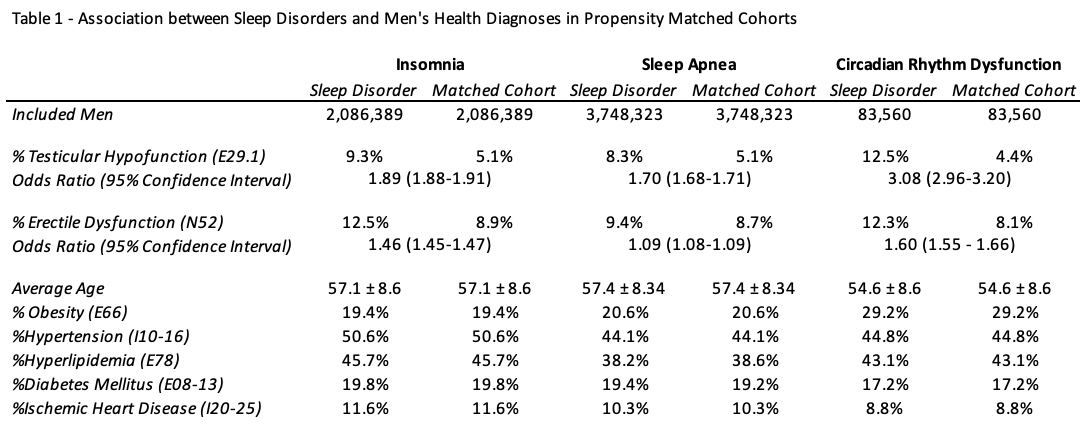Back
Poster, Podium & Video Sessions
Podium
PD49: Sexual Function/Dysfunction: Medical, Hormonal & Non-surgical Therapy II
PD49-10: Sleep Disorders and Circadian Rhythm Sleep Disorders Are Associated with Significantly Higher Rates of Hypogonadism and Erectile Dysfunction - A U.S. Claims Database Analysis
Sunday, May 15, 2022
5:00 PM – 5:10 PM
Location: Room 252
Pranjal Agrawal*, Sajya Singh, Baltimore, MD, Corey Able, Galveston, TX, Taylor P Kohn, Amin S Herati, Baltimore, MD
.jpg)
Pranjal Agrawal, BA
Johns Hopkins School of Medicine
Podium Presenter(s)
Introduction: Multiple small studies have found that sleep deprivation from sleep disorders can result in poor overall health and can negatively affect men’s health; however, all such studies have been small and performed at single institutions. Our objective was to assess the association of erectile dysfunction (ED) and hypogonadism with various sleep disorders using a national claims database.
Methods: The TriNetX Diamond network database was queried: a US health research network of 190 million patients, encompassing healthcare encounters and prescriptions between 2009-2021.
In men age 40-70 years, insomnia (ICD-10 G47.0), sleep apnea (G47.33), and circadian rhythm sleep disorder (G47.2) were each independently assessed to determine the association with ED (N52) and testicular hypofunction (E29.1). A propensity-score-matched control cohort was generated with an absence of any sleep disorders (G47 & F51), sleep deprivation (Z72.820), or morbid obesity with aveolar hypoventilation (E66.2). Propensity-score matching was performed for age, hypertension (I10-16), hyperlipidemia (E78), diabetes mellitus (E08-13), ischemic heart disease (I20-25), and obesity (E66).
Results: We identified 2,086,389 men with insomnia, 3,748,323 men with sleep apnea, and 83,560 men with circadian rhythm sleep disorder with an equal number of propensity-score matched control men (Table 1). Men with insomnia had higher rates of testicular hypofunction (9.3% vs 5.1%, OR 1.89, 95% CI 1.88-1.91). Men with sleep apnea were more likely to have testicular hypofunction (OR 1.70 [1.68-1.71]) but only slightly higher rates of ED (OR 1.09 [1.08-1.09]). Finally, men with circadian rhythm dysfunction had a very high association with testicular hypofunction (12.5% vs 4.5%, OR 3.1 [3.0-3.2]) and ED (OR 1.6 [1.5-1.7]).
Conclusions: In this large US claims analysis, sleep disorders (particularly circadian rhythm dysfunction) are strongly associated with hypogonadism and ED. Screening for poor sleep during work-up for hypogonadism and ED could help to catch these underlying diseases which can drastically impact overall health.
Source of Funding: None

Methods: The TriNetX Diamond network database was queried: a US health research network of 190 million patients, encompassing healthcare encounters and prescriptions between 2009-2021.
In men age 40-70 years, insomnia (ICD-10 G47.0), sleep apnea (G47.33), and circadian rhythm sleep disorder (G47.2) were each independently assessed to determine the association with ED (N52) and testicular hypofunction (E29.1). A propensity-score-matched control cohort was generated with an absence of any sleep disorders (G47 & F51), sleep deprivation (Z72.820), or morbid obesity with aveolar hypoventilation (E66.2). Propensity-score matching was performed for age, hypertension (I10-16), hyperlipidemia (E78), diabetes mellitus (E08-13), ischemic heart disease (I20-25), and obesity (E66).
Results: We identified 2,086,389 men with insomnia, 3,748,323 men with sleep apnea, and 83,560 men with circadian rhythm sleep disorder with an equal number of propensity-score matched control men (Table 1). Men with insomnia had higher rates of testicular hypofunction (9.3% vs 5.1%, OR 1.89, 95% CI 1.88-1.91). Men with sleep apnea were more likely to have testicular hypofunction (OR 1.70 [1.68-1.71]) but only slightly higher rates of ED (OR 1.09 [1.08-1.09]). Finally, men with circadian rhythm dysfunction had a very high association with testicular hypofunction (12.5% vs 4.5%, OR 3.1 [3.0-3.2]) and ED (OR 1.6 [1.5-1.7]).
Conclusions: In this large US claims analysis, sleep disorders (particularly circadian rhythm dysfunction) are strongly associated with hypogonadism and ED. Screening for poor sleep during work-up for hypogonadism and ED could help to catch these underlying diseases which can drastically impact overall health.
Source of Funding: None


.jpg)
.jpg)